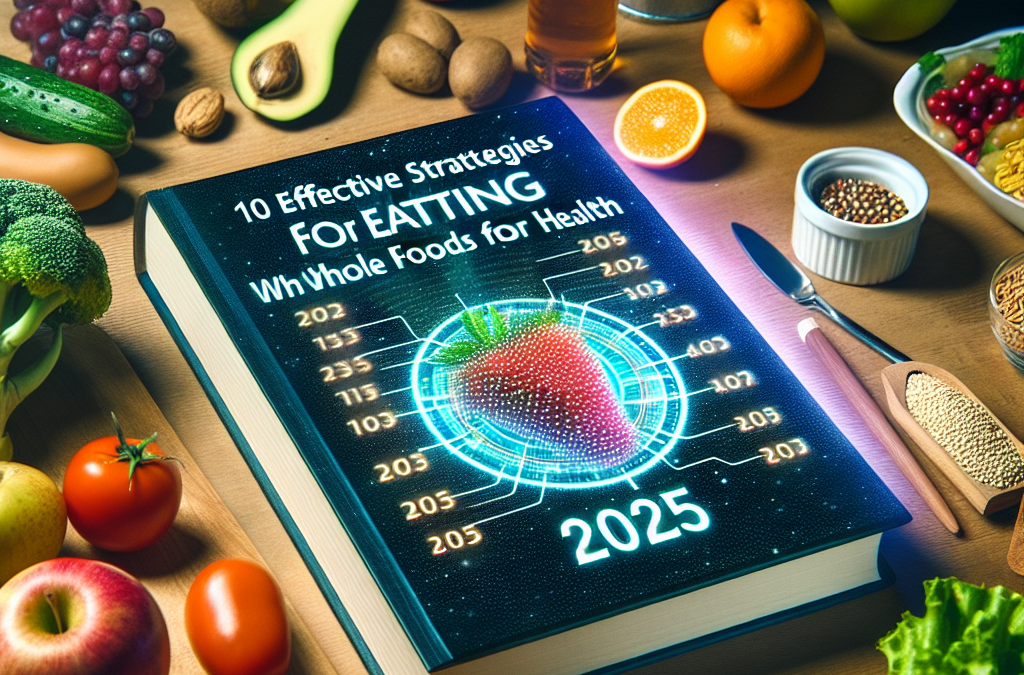- 1. Prioritize Organic and Local Produce
- 2. Incorporate Whole Grains into Your Diet
- 3. Choose Fresh, Unprocessed Proteins
- 4. Use Whole Foods in Meal Prep and Cooking
- 5. Read Labels Carefully to Avoid Additives
- 6. Experiment with Fermented Foods
- 7. Focus on Seasonal and Local Food Sources
- 8. Plan and Prepare Your Meals Ahead
- 9. Educate Yourself on Whole Food Benefits
- 10. Maintain Consistency and Track Progress
1. Prioritize Organic and Local Produce
Choosing Organic for Better Nutrition
In 2025, eating whole foods for health increasingly means prioritizing organic produce. Organic foods are grown without synthetic pesticides, fertilizers, or genetically modified organisms, making them a healthier choice. Consuming organic fruits and vegetables reduces your exposure to potentially harmful chemicals that can interfere with hormonal balance and immune function.
Research from the Organic Trade Association indicates that organic produce contains higher levels of antioxidants compared to conventionally grown foods. These antioxidants are vital for combating oxidative stress and inflammationâa common concern in todayâs health landscape. Making organic choices not only supports your health but also contributes to sustainable farming practices.
Moreover, shopping at local farmersâ markets allows you to access fresher, more nutrient-dense produce. Local growers often use fewer pesticides and prioritize soil health, which benefits not just your health but the environment too.
Benefits of Seasonal and Local Foods
Eating seasonally helps you incorporate a diverse range of whole foods into your diet throughout the year. Seasonal produce tends to be more flavorful and nutrient-rich, making it an ideal choice for optimal health in 2025. When you buy locally, you also cut down on the carbon footprint associated with food transportation.
Supporting local farmers boosts your community’s economy and encourages environmentally friendly farming practices. As part of your strategy for eating whole foods for health, prioritize locally grown, seasonal vegetables and fruits whenever possible.
Tip: Join a community-supported agriculture (CSA) program to regularly receive fresh, seasonal produce directly from farmers. This ensures that your diet remains diverse and nutrient-packed all year long.
2. Incorporate Whole Grains into Your Diet
Why Whole Grains Matter
Whole grains are an essential component of eating whole foods for health because they contain all parts of the grain â bran, germ, and endosperm. In 2025, thereâs a growing body of evidence showing that consuming whole grains can reduce the risk of chronic diseases such as heart disease, diabetes, and certain cancers.
Recent studies show that replacing refined grains with whole grains can improve gut health due to increased fiber content. Fiber aids digestion, helps regulate blood sugar levels, and promotes feelings of fullness, which can support weight management.
Popular whole grains include oats, quinoa, brown rice, barley, and whole wheat. Incorporating a variety of these into your meals can diversify your nutrient intake and keep your diet exciting.
Practical Tips for Adding Whole Grains
Start by swapping out white rice for brown rice or quinoa in your meals. Experiment with whole wheat pasta or bread, and consider adding oats to smoothies or yogurt. Preparing grains in advance helps you integrate them seamlessly into your daily routine.
Remember, even small changes can make a big difference. For example, using whole grain flour in baking or adding seeds like flax or chia to your breakfast can enhance fiber and omega-3 intake.
In 2025, many health-conscious consumers are making these simple swaps, leading to better overall nutrition and increased energy levels.
3. Choose Fresh, Unprocessed Proteins
The Importance of Protein Quality
Eating whole foods for health in 2025 means selecting fresh, unprocessed protein sources. High-quality proteins such as lean meats, poultry, eggs, fish, beans, and nuts provide essential amino acids that support muscle growth, immune function, and overall vitality. Avoid heavily processed meats like sausages or deli meats, which often contain preservatives and additives.
Wild-caught fish, such as salmon and sardines, are excellent options because they are rich in omega-3 fatty acids, crucial for brain health and inflammation reduction. Plant-based proteins like lentils and chickpeas are also gaining popularity among health-conscious individuals for their fiber and nutrient benefits.
By choosing fresh, unprocessed proteins, you support your body’s natural ability to heal, regenerate, and thrive in 2025.
Storage and Preparation Tips
Buy proteins in their freshest form from trusted sources. Proper storage in your refrigerator or freezer extends their shelf life. Cooking methods like grilling, baking, or steaming preserve nutrients and avoid unnecessary additives.
Integrate a variety of protein sources into your weekly meal plans. For example, breakfast could include eggs or Greek yogurt, while dinner could feature grilled fish or lentil stew. Planning ahead ensures you always have wholesome options on hand.
Remember, maintaining a balanced intake of different proteins complements your overall diet for optimal health.
4. Use Whole Foods in Meal Prep and Cooking
Transforming Recipes with Whole Ingredients
In 2025, cooking with whole foods is more accessible and enjoyable than ever. By preparing meals from scratch using whole ingredients, you control the quality and avoid processed additives that can detract from your health goals. This approach aligns perfectly with eating whole foods for health.
Start by replacing processed sauces, dressings, and snacks with homemade versions using fresh herbs, vegetables, and nuts. For example, make a vibrant vegetable stir-fry using fresh, chopped produce or prepare hearty salads with whole grains and nuts.
This not only enhances flavor but ensures youâre consuming maximum nutrients, supporting your bodyâs needs in this health-conscious era.
Batch Cooking and Meal Planning
Batch cooking weekly allows you to prepare nutritious, whole food meals in advance, saving time and reducing reliance on convenience foods. Use large pots or slow cookers to make stews, soups, and grain bowls packed with whole ingredients.
Invest in good-quality storage containers to keep your meals fresh and well-organized. Planning your meals with whole foods in mind helps you stay consistent and reduces food waste. This strategy will keep you on track for healthy eating throughout 2025.
By incorporating whole foods into your meal prep routine, you’re making a sustainable choice that benefits both your health and the planet.
5. Read Labels Carefully to Avoid Additives
Understanding Food Labels
In the era of 2025, reading labels has become indispensable to eating whole foods for health. Many packaged foods contain artificial preservatives, flavors, sweeteners, and other additives that can undermine your health goals.
Look for products with simple, recognizable ingredientsâideally, items that list only whole food components. This habit ensures that your diet remains as close to natural as possible.
Developing this awareness helps you make informed choices and avoid hidden processed ingredients that can contribute to inflammation and chronic diseases.
Practical Label-Reading Tips
Create a checklist of ingredients to avoid, such as artificial sweeteners, MSG, and preservative E-numbers. Focus on purchasing foods with minimal ingredients, ideally less than five, with no added sugars or artificial chemicals.
Some supermarkets now offer âclean labelâ or âwhole foodâ sectionsâuse these to simplify your shopping. Additionally, consider using smartphone apps that scan labels and flag unhealthy additives.
By being vigilant, you can ensure that your commitment to eating whole foods for health stays intact, providing your body with the nourishment it truly deserves.
6. Experiment with Fermented Foods
Adding Gut-Friendly Fermented Foods
Fermented foods are a powerful addition to an eating whole foods for health plan in 2025. They contain probioticsâbeneficial bacteria that support gut health, digestion, and immune function. Incorporate foods like kefir, sauerkraut, kimchi, and yogurt into your daily diet.
A healthy gut is linked to reduced inflammation and improved mental clarity, both essential for overall well-being. Plus, fermented foods add vibrant flavors and texture to meals, making healthy eating enjoyable.
Get an Amazing Discount on the Best Certified Organic Whole Food Supplement!
Start slowly by adding a spoonful of sauerkraut to your sandwich or blending kefir into smoothies. Over time, your gut microbiome will become more diverse and resilient.
Making Fermented Foods at Home
Homemade fermentation is simple and cost-effective. Using fresh vegetables and natural fermentation methods, you can create delicious probiotic-rich foods tailored to your taste. Ensure proper sanitation and fermentation time to prevent unwanted bacteria growth.
Experiment with different vegetables, flavors, and fermentation durations. Document your recipes to develop a variety of fermented foods suitable for your palate and health needs.
This approach allows you to maximize the benefits of eating whole foods for health in 2025 and beyond.
7. Focus on Seasonal and Local Food Sources
The Advantages of Eating Seasonally
Eating seasonally is a key strategy for eating whole foods for health in 2025. Seasonal foods are harvested at their peak ripeness, making them richer in nutrients and flavor. This practice naturally diversifies your diet and aligns with the natural growing cycles.
Incorporate a variety of seasonal vegetables and fruits like asparagus in spring, berries in summer, squash in fall, and hardy greens in winter. This approach supports optimal health and reduces reliance on imported and preserved foods.
Additionally, shopping locally reduces your carbon footprint and supports sustainable agriculture efforts which are increasingly important in 2025.
Tips for Sourcing Local and Seasonal Foods
Visit farmersâ markets regularly and talk to growers about their harvest times. Join local food co-ops or farm subscriptions for a steady supply of fresh, seasonal produce.
Use seasonal guides and apps to plan your shopping and recipes accordingly. Preparing meals with in-season ingredients guarantees maximum nutrient retention and flavor.
This conscientious approach embodies the core idea of eating whole foods for health, promoting both personal wellness and environmental sustainability in 2025.
8. Plan and Prepare Your Meals Ahead
Meal Planning for Success
Consistent success with eating whole foods for health in 2025 depends on thoughtful meal planning. Dedicate some time each week to plan meals, create shopping lists, and prep ingredients. This reduces impulsive eating and reliance on processed foods.
Batch prepping items such as chopped vegetables, cooked grains, and roasted proteins saves time and ensures healthy options are readily available. Keep a variety of whole food staples in your pantry and fridge to allow flexibility and creativity.
This proactive approach not only supports your health goals but also reduces stress around meal times, making healthy eating more sustainable.
Organizing Your Kitchen for Whole Food Cooking
A well-organized kitchen with designated spots for whole foods inspires regular use. Keep fresh produce visible at eye level, store grains and nuts in airtight containers, and prepare ingredients ahead of meals.
Use meal planners or apps to track your progress and stay motivated. Incorporating planning into your routine in 2025 helps maintain consistent eating habits that prioritize eating whole foods for health.
From practical prep tips to strategic organization, this habit is key for a healthier, more balanced lifestyle.
9. Educate Yourself on Whole Food Benefits
The Power of Knowledge
Staying informed is vital for making smart choices about eating whole foods for health. Read scientific articles, books, and reputable health blogs dedicated to whole food nutrition. In 2025, understanding the latest research helps you adapt your diet for maximum benefit.
Learning about how different foods influence your body can motivate you to stick with healthy habits. For example, knowing that antioxidants from berries combat aging, or that fiber-rich foods improve gut health, reinforces your commitment to eating whole foods.
Continuous education also helps you navigate trends and product claims, ensuring your choices remain evidence-based and beneficial.
Resources and Tools for Learning
Follow trusted nutrition experts on social media, subscribe to health newsletters, and participate in local workshops or cooking classes focused on whole foods. Use reputable apps to track your nutrient intake and meal goals.
By prioritizing education, you empower yourself to make consciously healthy choices that align with your values and health needs in 2025.
10. Maintain Consistency and Track Progress
The Importance of Consistency
Success in eating whole foods for health in 2025 depends heavily on consistency. Establish daily routines that incorporate whole foods, whether through breakfast, snacks, or dinner. Over time, these small habits create lasting change.
Keep a food journal or use apps to track your intake and observe patterns. Monitoring your progress helps identify areas for improvement and keeps you motivated.
Celebrate your milestones, such as trying a new whole food recipe or achieving a month of meal prep. Recognition reinforces healthy habits and encourages ongoing commitment.
Adjusting and Improving Your Approach
Be flexible and willing to adapt your strategies as you learn what works best for your lifestyle. Regularly revisit your goals to ensure they remain realistic and motivating. Incorporate variety to prevent boredom and nutritional gaps.
The key to long-term health benefits from eating whole foods for health is consistent effort combined with mindful adjustments. By tracking and refining your habits, you’ll enjoy sustained wellness into 2025 and beyond.
Conclusion
In 2025, embracing effective strategies for eating whole foods for health is essential for achieving optimal well-being. From choosing organic, local produce to meal planning and education, each step helps you build a sustainable, nourishing diet. Remember, the journey to health is a marathon, not a sprint, and consistency is key. Incorporate these ten strategies into your routine, and you’ll be well on your way to a healthier, happier life â all while supporting the planet. Prioritize eating whole foods for health, and watch your vitality grow this year and beyond.
Frequently Asked Questions
1. Why is eating whole foods for health important in 2025?
Eating whole foods for health in 2025 is vital because it reduces exposure to harmful additives, boosts nutrient intake, and supports sustainable practices, helping you stay healthy in an evolving food landscape.
2. How can I start eating more whole foods today?
Begin by planning your meals around fresh fruits, vegetables, whole grains, and unprocessed proteins. Gradually replace processed snacks with whole food alternatives, and read labels carefully.
3. What are some easy ways to incorporate fermented foods?
Start with simple options like adding yogurt or kefir to your breakfast, or include small servings of sauerkraut or kimchi as side dishes. Making fermented foods at home is also a rewarding option.
4. How does seasonal eating benefit my health?
Seasonal eating ensures nutrient-dense, flavorful foods at their peak ripeness, supporting better health, reducing environmental impact, and encouraging a varied diet throughout the year.




